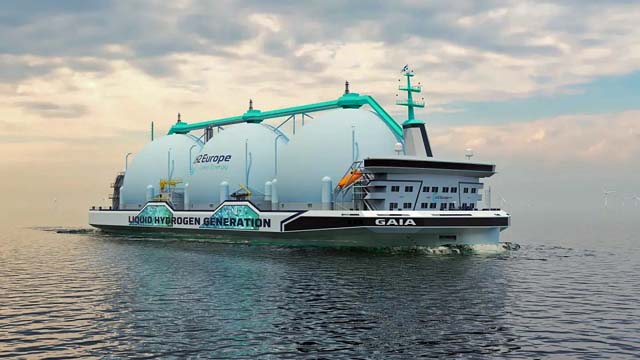C-Job Naval Architects has designed a new class of liquid hydrogen tanker that the company believes will revolutionise the renewable energy market.
The tanker concept, developed in partnership with LH2 Europe, is considered a critical element in realising a green end-to-end liquid hydrogen supply chain.
Dr Peter Wells, CEO LH2 Europe, said: “Hydrogen will be essential to the future of energy. It is up to us how quickly we can make that happen. This tanker design is a key step in providing the infrastructure to make that clean energy future a reality. Current vessels in operation are not able to deliver hydrogen at the scale we expect will be required to meet the needs of the market.”
To do this, LH2 Europe will use the abundant amount of renewable electricity in Scotland to produce green hydrogen and market it at a competitive price with diesel. The new tanker will then transport the liquid hydrogen from Scotland to Germany. The tanker has enough capacity onboard to deliver fuel for 400,000 medium-sized hydrogen cars or 20,000 heavy trucks. As it is currently planned, the tanker will deliver 100t/day of hydrogen, and gradually increase the delivery to 300t/day, depending on demand.
Job Volwater, CCO C-Job, said: “Liquid hydrogen provides unique challenges in ship design and engineering. As a comparison, LNG tankers use ballast water to compensate the loss of weight following delivery to ensure enough draught. As liquid hydrogen is high in volume but 20 times lighter than LNG, this required a unique solution. We have created a trapezium-shaped hull design which creates enough deck space to fit the tanks without the need for ballast.”
When completed, the liquid hydrogen tanker will be 141m long and will have a storage capacity of 37,500m3. The vessel will be powered by hydrogen fuel cells and will be equipped with three liquid hydrogen storage tanks. The tanks will have a much lower boil off than those currently used in the maritime industry. The limited remaining boil off will be captured and directly utilised in the hydrogen fuel cells, providing power to the vessel’s propulsion systems, resulting in emissions of water only. The vessel itself will have zero greenhouse gas emissions during operations.
The ship is expected to be ready and commissioned six months before the first delivery of hydrogen in 2027.



